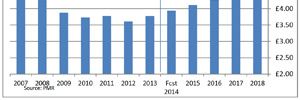
 Growing consumer confidence, a burgeoning housing market and a low interest rate environment helped boost the domestic glazing market in Great Britain in 2013 according to Palmer Market Research (PMR), which is also predicting that growth will continue through to 2018. And according to Robert Palmer, director of PMR: “We’re entering the longest period of prolonged growth for this market since the ‘90s.”
Growing consumer confidence, a burgeoning housing market and a low interest rate environment helped boost the domestic glazing market in Great Britain in 2013 according to Palmer Market Research (PMR), which is also predicting that growth will continue through to 2018. And according to Robert Palmer, director of PMR: “We’re entering the longest period of prolonged growth for this market since the ‘90s.”
,According to PMR, after continuing to decline in the first quarter of 2013, the market ‘dramatically switched to growth’ in the second quarter, ending up for the year nearly 5% higher at £3.78 billion. By sector, the market in new build housing shot up 17% and in home improvements by a more modest 4%. Only social housing refurbishment failed to see an increase, down just over 2%.
,Government initiatives, in particular the Help to Buy scheme, are said to have had an important effect on new build and will continue to do so through to 2018 and even beyond, PMR predicts.
,Despite PMR’s fears that rising interest rates will be ‘something of a dampener’, by 2018 the market is still forecast to be 50% bigger than it was in 2013.
,The strengthening housing market itself is also said to be helping home improvements, as homeowners feel that these are ‘now worth making again’. The higher number of housing transactions boosted the replacement market, which saw growth for the first time in 10 years. Overall, it is believed that the home improvement market will grow by nearly a fifth between 2013 and 2018.
,More negatively, PMR says that funding issues after the winding down of the Decent Homes Programme will mean little or no growth in social housing refurbishment over the period to 2018.
,Aluminium started to make a comeback in 2013, with its share growing from 5% to 8%. Disappointingly, the bi-fold door failed to maintain the growth it saw in previous years; rather than increasing, the market actually fell by 7%.
,Although Palmer’s forecast has been downgraded since last year, the market for bi-folds is still seen as growing in the long term, not least because, according to Palmer, bi-folds are an ‘aspirational’ part of the growing trend to brick built extensions.
,In the window market, vertical sliding sash and tilt and turn styles saw growth of a fifth in 2013, while in the entrance door market, composites increased their dominance to reach 40% share.
,The conservatory market continues to disappoint with a 2% fall in 2013. But that masks a near 40% growth in replacements and a 10% decline in first time installations.
,According to PMR, triple glazing is ‘still in its infancy’ in this market. In 2013, incidence in windows was between 1 and 2% according to sector, but more than double that in entrance doors. “Triple glazing is bound to grow strongly in the coming years as it becomes an irresistible marketing challenge for suppliers,” said Palmer.
,The Window, Door and Conservatory Markets in Housing in Great Britain, 2014 edition, was developed by carrying out structured interviews with 674 companies operating in the market, including housebuilders, manufacturers, and housing associations, between April and June 2014.
,For full details, visit www.palmermarketresearch.co.uk



